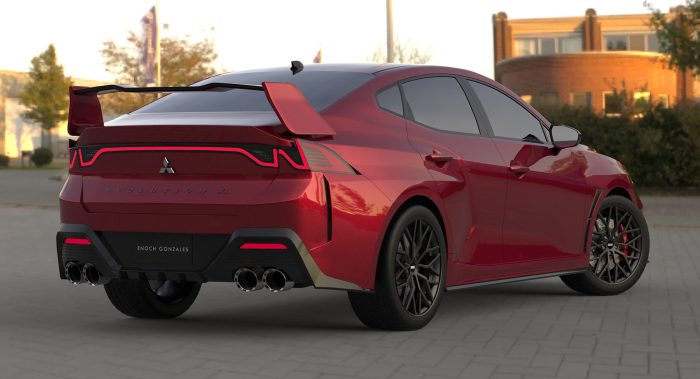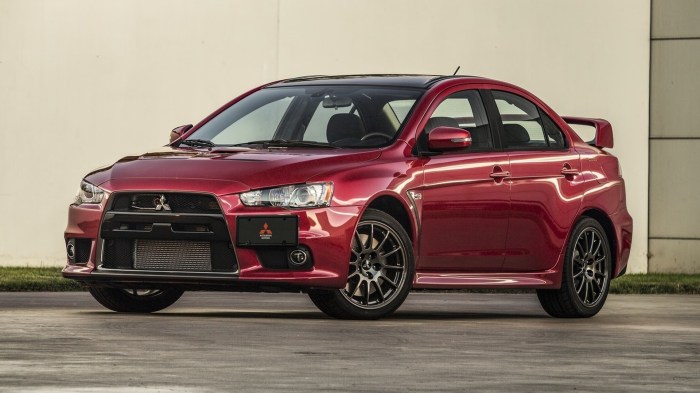Is Mitsubishi bringing back the Evo? The iconic Lancer Evolution, a legend in the automotive world, may be making a grand return. With rumors and speculations swirling, let’s dive into the potential revival of this legendary performance sedan.
Mitsubishi’s history with the Lancer Evolution is a testament to its significance. From its humble beginnings to its rally-dominating legacy, the Evo has left an unforgettable mark on the automotive landscape. As we explore the potential return of this beloved machine, we’ll examine the reasons behind Mitsubishi’s consideration, the challenges they might face, and the thrilling possibilities that lie ahead.
Mitsubishi’s History with the Lancer Evolution
Mitsubishi’s Lancer Evolution, commonly known as the Evo, is a high-performance sports sedan that has gained a cult following among car enthusiasts worldwide. The Evo’s genesis can be traced back to Mitsubishi’s participation in the World Rally Championship (WRC) in the late 1980s.The
Lancer Evolution was born out of Mitsubishi’s need for a homologation model to compete in the WRC’s Group A category. The first generation Evo, based on the Lancer EX, was introduced in 1992. It featured a turbocharged 2.0-liter engine, all-wheel drive, and a stripped-down interior.
Key Features and Specifications of Each Generation
The Lancer Evolution has undergone several iterations over the years, each generation bringing its own unique set of improvements and advancements. First Generation (1992-1994)
- 2.0-liter turbocharged engine
- 247 horsepower
- All-wheel drive
- 5-speed manual transmission
Second Generation (1994-1995)
- 2.0-liter turbocharged engine
- 276 horsepower
- All-wheel drive
- 5-speed manual transmission
Third Generation (1995-1996)
- 2.0-liter turbocharged engine
- 280 horsepower
- All-wheel drive
- 5-speed manual transmission
Fourth Generation (1996-1998)
- 2.0-liter turbocharged engine
- 280 horsepower
- All-wheel drive
- 5-speed manual transmission
Fifth Generation (1998-2001)
- 2.0-liter turbocharged engine
- 276 horsepower
- All-wheel drive
- 5-speed manual transmission
Sixth Generation (2001-2004)
- 2.0-liter turbocharged engine
- 280 horsepower
- All-wheel drive
- 5-speed manual transmission
Seventh Generation (2004-2006)
- 2.0-liter turbocharged engine
- 280 horsepower
- All-wheel drive
- 5-speed manual transmission
Eighth Generation (2006-2007)
- 2.0-liter turbocharged engine
- 291 horsepower
- All-wheel drive
- 5-speed manual transmission
Ninth Generation (2007-2015)
- 2.0-liter turbocharged engine
- 291 horsepower
- All-wheel drive
- 5-speed manual transmission or 6-speed dual-clutch transmission
Tenth Generation (2015-2016)
- 2.0-liter turbocharged engine
- 303 horsepower
- All-wheel drive
- 5-speed manual transmission or 6-speed dual-clutch transmission
Rumors and Speculations Surrounding the Evo’s Return

Mitsubishi’s recent actions have sparked rumors and speculations about the potential return of the iconic Lancer Evolution. Various sources have reported on the possibility of a new Evo model, with some suggesting it could be an electric or hybrid vehicle.
Potential Reasons for Reviving the Evo
Mitsubishi may consider reviving the Evo for several reasons:
- Brand Heritage:The Evo has a strong brand heritage and loyal fan base. Reviving it could help Mitsubishi reconnect with its performance-oriented roots and attract new customers.
- Market Demand:There is still a strong demand for high-performance sedans, particularly among enthusiasts. Bringing back the Evo could tap into this market and compete with rivals like the Subaru WRX STI and Honda Civic Type R.
- Technology Advancements:Mitsubishi has made significant advancements in electric and hybrid technology in recent years. Reviving the Evo as an electrified vehicle could showcase these advancements and position Mitsubishi as a leader in sustainable performance.
Challenges in Bringing Back the Evo
Despite the potential benefits, Mitsubishi may also face some challenges in bringing back the Evo:
- Development Costs:Developing a new sports car is a costly endeavor, especially if it involves advanced technologies like electrification. Mitsubishi would need to carefully consider the financial implications.
- Market Competition:The performance sedan market is highly competitive, with established rivals like the Subaru WRX STI and Honda Civic Type R. Mitsubishi would need to differentiate the Evo and offer something unique to stand out.
- Meeting Emissions Regulations:With increasingly stringent emissions regulations, Mitsubishi would need to ensure that the Evo meets environmental standards while still delivering the performance expected from the nameplate.
Potential Design and Specifications of the New Evo: Is Mitsubishi Bringing Back The Evo

The new Evo, if it does make a comeback, is expected to retain the iconic design elements that made it so popular in the first place. These include the aggressive front fascia with the signature triple-diamond grille, the flared fenders, and the large rear spoiler.
However, the new Evo is also likely to incorporate some modern design cues, such as LED headlights and taillights, and a more aerodynamic body.Under the hood, the new Evo is rumored to be powered by a turbocharged 2.0-liter four-cylinder engine that produces around 350 horsepower and 300 lb-ft of torque.
This would give the new Evo a significant power advantage over its predecessor, which had a 2.0-liter turbocharged four-cylinder engine that produced 291 horsepower and 300 lb-ft of torque.In terms of performance, the new Evo is expected to be able to accelerate from 0 to 60 mph in under 5 seconds and reach a top speed of over 160 mph.
This would make the new Evo one of the fastest sedans on the market.The new Evo is also expected to be equipped with a number of technological advancements, such as a new all-wheel-drive system, a revised suspension system, and a new infotainment system.
These advancements would help to improve the new Evo’s handling, performance, and comfort.
Exterior Design, Is mitsubishi bringing back the evo
The new Evo is expected to have a more aggressive and aerodynamic exterior design than its predecessor. The front fascia will likely feature a larger grille with a more pronounced diamond-shaped design. The headlights will likely be LED units with a more angular shape.
The side profile of the new Evo is expected to be more sculpted, with flared fenders and a more pronounced rear spoiler. The rear fascia will likely feature a new diffuser and taillights with a more modern design.
Interior Design
The interior of the new Evo is expected to be more spacious and comfortable than its predecessor. The dashboard will likely be redesigned with a more modern and ergonomic layout. The seats will likely be more supportive and comfortable, and the materials used throughout the interior will likely be of higher quality.
Powertrain
The new Evo is expected to be powered by a turbocharged 2.0-liter four-cylinder engine that produces around 350 horsepower and 300 lb-ft of torque. This engine will likely be mated to a six-speed manual transmission or an optional eight-speed automatic transmission.
Performance
The new Evo is expected to be able to accelerate from 0 to 60 mph in under 5 seconds and reach a top speed of over 160 mph. This would make the new Evo one of the fastest sedans on the market.
Technology
The new Evo is expected to be equipped with a number of technological advancements, such as a new all-wheel-drive system, a revised suspension system, and a new infotainment system. These advancements would help to improve the new Evo’s handling, performance, and comfort.
Market Demand and Competition
The global market for high-performance sedans has experienced steady growth in recent years, driven by increasing demand for vehicles that offer both practicality and exhilarating driving experiences. This trend is expected to continue in the coming years, creating a favorable environment for the return of the Mitsubishi Evo.
The new Evo will face stiff competition from established players in the segment, including the Subaru WRX STI, Volkswagen Golf R, and Honda Civic Type R. Each of these competitors offers a unique blend of performance, features, and price, making it essential for Mitsubishi to differentiate the Evo to stand out.
Strategies for Differentiation
To differentiate the Evo from its competitors, Mitsubishi could employ several strategies:
- Focus on rally heritage:The Evo has a rich history in rally racing, and Mitsubishi could leverage this heritage to appeal to enthusiasts who value performance and handling.
- Offer a unique driving experience:The Evo could be tuned to provide a more engaging and responsive driving experience than its competitors, appealing to drivers who seek a thrilling ride.
- Emphasize value for money:Mitsubishi could position the Evo as a more affordable alternative to its competitors, offering a competitive price point without sacrificing performance.
Impact on Mitsubishi’s Brand and Sales
The return of the Evo is expected to have a significant impact on Mitsubishi’s brand image and sales figures. The Evo has a cult following among car enthusiasts, and its return is likely to generate a lot of excitement and buzz.
This could lead to increased brand awareness and a boost in sales for Mitsubishi.
In terms of sales figures, it is difficult to estimate exactly how many units of the new Evo Mitsubishi will sell. However, based on the popularity of the previous generations of the Evo, it is reasonable to expect that the new model will sell well.
Mitsubishi has also stated that it plans to produce a limited number of units of the new Evo, which could help to drive up demand and prices.
Financial Benefits
The financial benefits of bringing back the Evo are also likely to be significant. The Evo is a high-performance car, and it is likely to command a premium price. This could lead to increased profits for Mitsubishi. Additionally, the Evo could help to attract new customers to the Mitsubishi brand, which could lead to increased sales of other Mitsubishi models.
Ultimate Conclusion
The return of the Mitsubishi Evo, if it comes to fruition, would be a significant event in the automotive industry. It would not only revive a legendary nameplate but also inject a much-needed dose of excitement into the performance sedan market.
While the path ahead may not be without challenges, Mitsubishi has the potential to create a vehicle that lives up to the Evo’s legendary status and captures the hearts of enthusiasts worldwide.
